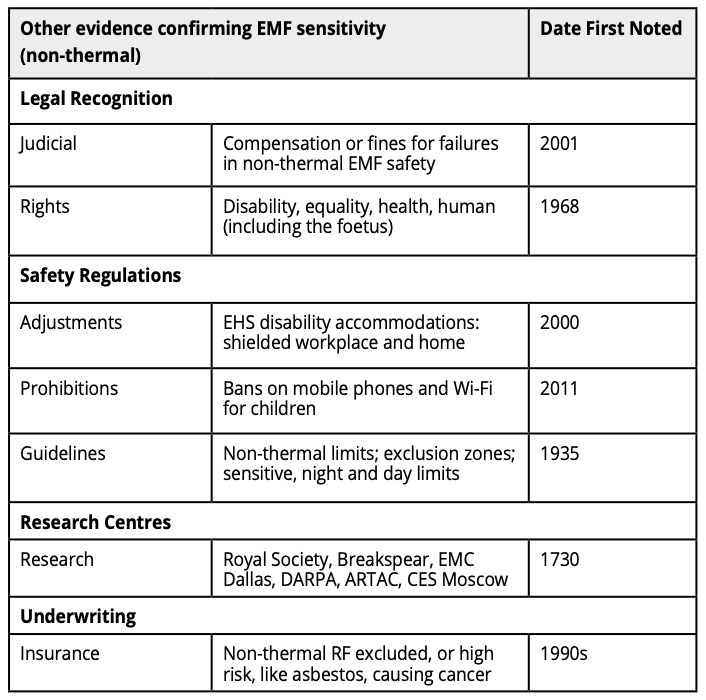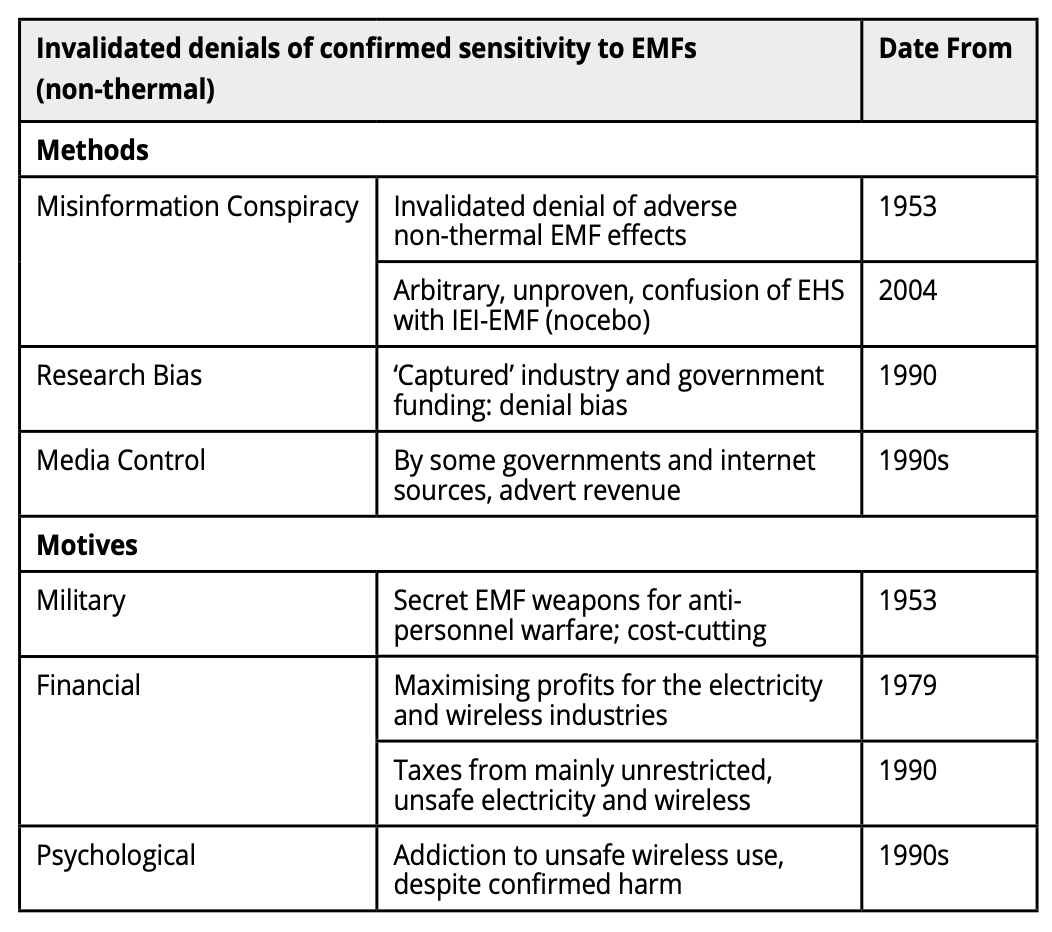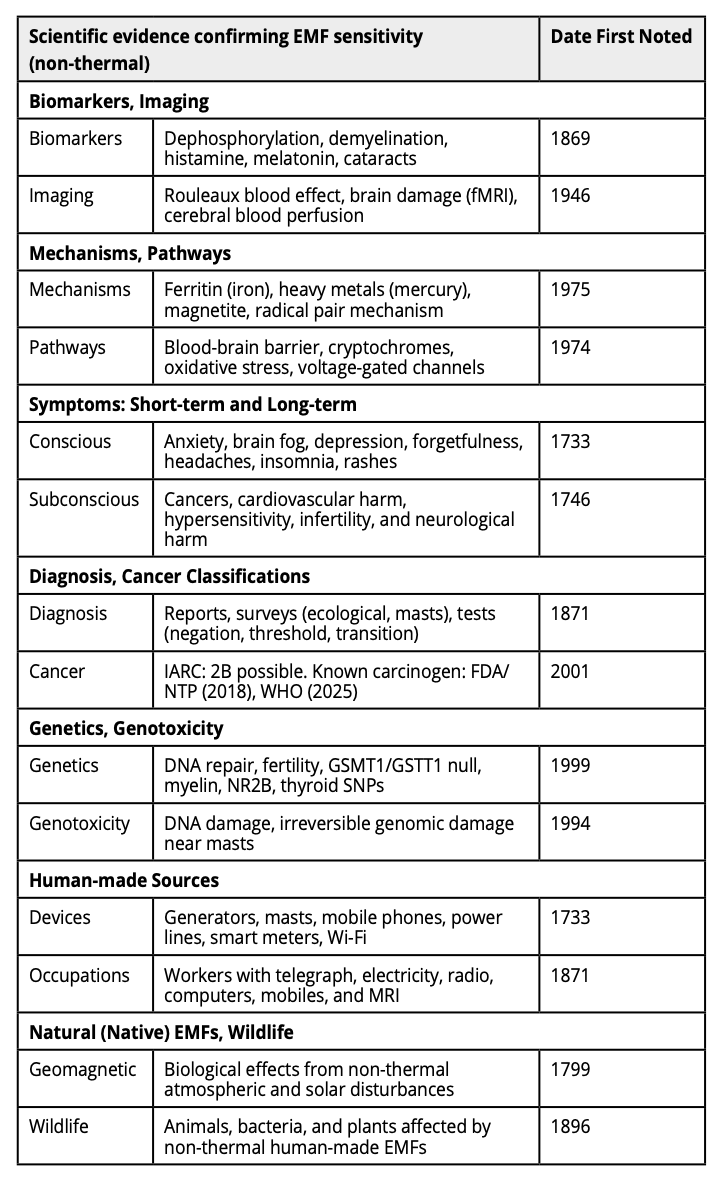Michael Bevington of Electrosensitivity UK advocates for recognising the health and environmental impacts of human-made electromagnetic fields (EMFs), citing both historical and legal acknowledgement as well as scientific research linking EMFs to various symptoms
Symptoms of sensitivity to human-made electromagnetic fields (EMFs) were first described in 1733, and the condition now known as Electromagnetic Hypersensitivity (EHS) was identified by 1746. Both claims have been supported by extensive scientific research. Furthermore, EHS has been legally and practically recognised. However, the Western military-industrial complex continues to deny this well-documented evidence.
Scientific evidence confirms EHS symptoms
Many biophysical mechanisms and pathways of EMF sensitivity are now established, along with biomarkers, imaging, and genetic factors (Table 1). These confirm the long-term adverse effects from EMFs, including non-thermal radiofrequency (RF), such as cancers, cardiovascular and neurological harm, and infertility. Scientific research has also confirmed short-term conscious symptoms, like headaches, brain fog, depression, and insomnia, as in the mainstream Scientific Consensus International Report of 2021 by 32 worldwide experts on physiological EHS. Convincing and consistent scientific evidence also confirms non-thermal adverse effects on wildlife.

Other evidence confirms EHS
There is substantial evidence supporting non-thermal electromagnetic field (EMF) sensitivity, as outlined in Table 2. This includes legal compensation and fines for failing to protect individuals with electromagnetic hypersensitivity (EHS), as well as the establishment of non-thermal safety limits and prohibitions. Additionally, some underwriters either refuse EMF insurance or classify it as high risk. Furthermore, there are disability rights and accommodations available for people with Electromagnetic Hypersensitivity.
Invalidated denial of Electromagnetic Hypersensitivity
Invalidated attempts at denying non-thermal adverse EMF effects, including EHS and its symptoms, have been made since 1953. That year, RF was found to cause cancer and was first used in warfare (Table 3). This 72-year denial, longer than for smoking, is one of the longest denials of confirmed evidence in the history of science.
Methods
(a) Misinformation conspiracy
Professor Robert Becker in 1990 called this misinformation – propagating unscientific denials of confirmed adverse non-thermal EMF effects – a ‘conspiracy’. Similar misinformation, without proof, invalidly confuses two separate conditions, physical EHS and psychological electrophobia.
(b) Research bias
Groups ‘captured’ by the wireless industry typically produce biased research denying harm. However, there is a paradigm shift on EMF sensitivity in the US, with DARPA studying pilots suffering EHS symptoms like spatial confusion from radar and jammers.
(c) Media control
Some biased internet search engines and websites suppress confirmed scientific evidence for EHS but highlight spurious denials. Some authorities arbitrarily ban information posters and media reports on confirmed EHS. Wireless companies can threaten advertising revenue.
Motives
(a) The military-industry complex: secret warfare and profits
In 1984, Professor Nicholas Steneck described the US’s EMF thermal limits as ‘a military-industry’ standard aiming ‘to maximise opportunities to expand the use of RF technology’. From 1953, the US, unlike Eastern countries, adopted Schwan’s invalidated thermal hypothesis, that RF causes harm only through heating. Thermal limits prevent a temperature rise of 1oC based on continuous RF exposure. This heating hypothesis was disproved in 1962, when the same incident level of continuous and pulsed RF energy averaged over one hour produced the same intraocular increase of 5.8oC; however, only pulsed, not continuous RF, caused cataracts.
Military pressure from 1953 protected secret non-thermal RF warfare. Cost-cutting avoided buying land for non-thermal radar safety zones.
Industry and governments prioritised profits and tax revenue. Since EHS symptoms are non-thermal, those denying non-thermal effects also deny the existence of EHS. In 2004, the World Health Organization, subject to the United Nations’ economic growth agendas, arbitrarily denied that EMFs caused EHS symptoms, although this cause was established in 1733 and for RF in 1889.

(b) Wireless addiction
Some people are addicted to unrestricted wireless use. They ignore confirmed evidence of non-thermal harm and mistakenly assume that governments protect them. However, under military- industry influence, some governments prioritise taxes and profits over health, non-thermal limits and preventing EHS.


